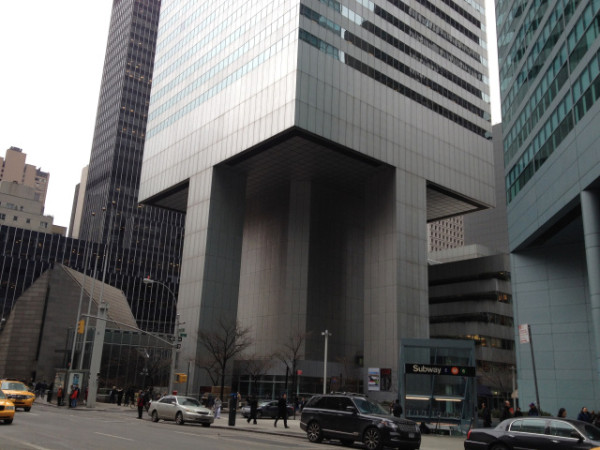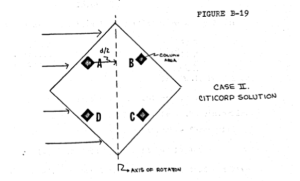99% Invisible is honored to accept a 2015 Third Coast International Audio Festival award for Structural Integrity, a story of architectural engineering gone wrong, and then covertly made right.
When it was built in 1977, the 59-story Citicorp Center had a potentially fatal flaw that could have caused the building to collapse during a severe storm, and take out the entire Midtown Manhattan skyline with it. This flaw (and the plan to fix it) was so secret, that even the person who found the problem only discovered the full story decades later.

The story, which was later written up as a case study in architectural ethics, went like this: a student doing a project on the newly-completed CitiCorp Center telephoned the structural engineer, William LeMessurier, out of the blue. The student said that LeMessurier had made a grave miscalculation with the building–that he had accounted for the perpendicular winds, but not the quartering winds which hit the building at its corners. Once the latter forces were factored in to the equation, the corrected math was shocking: for every year that CitiCorp Center was standing, there was about a 1-in-16 chance that a storm could hit New York and take it down.

Emergency retrofits were made with cooperation of the NYPD, which drew up an evacuation plan spanning a 10 block radius in the event of catastrophic weather. In addition, 2,500 Red Cross volunteers were on standby, and three different weather services employed 24/7 to keep an eye on potential windstorms. With a hurricane on the horizon, workers welded throughout the night, quitting at daybreak just as the building occupants returned to work.
But all of this happened in secret. The public was none the wiser until The New Yorker broke the story of this clandestine operation in 1995.
The student who called LeMessurier, though, was lost to history. Or was he?
Structural Integrity was produced by reporter Joel Werner and 99% Invisible’s own Sam Greenspan.
Among the eight other awards given out, two other Radiotopia shows also winners. Categories for each winner will be announced later this month during an award ceremony at the Filmless Festival in Chicago. Listen to the two other Radiotopia recipients of this year’s Third Coast awards below.
695BGK was produced by Lauren Spohrer and Phoebe Judge for Criminal
The Living Room was produced by Briana Breen with editing, mixing and scoring by Brendan Baker for Love + Radio





Comments (12)
Share
Congratulations! From a big fan of 99PI in Israel.
So happy for you all. Well deserved. I am so glad one of my favorite episodes won! Thanks for posting the other two winners. The Criminal story happened minutes from my house, and I had caught the Love + Radio story on PRX chanell 123 on Sirus, All I can say is WOW what a moving story.
Congratulations! Thought this could be turned into a screenplay.
Okay I have a serious question: Why didn’t they just design the structure using the same placement of the stilts but with the upper portion of the building rotated around 45º? That way the corners would line up with the legs, giving the structure the same “4-legged table” design we all know and love. Was it really that important to have the sides of the building parallel to the streets? Or could they just not spare having 50% less floor space?
Because that building wouod have a far smaller footprint and would be a less efficient usage of space. Try drawing a diagonal square inside of another square. See how much less area it fills.
Ugh I love when you guys do architecture and building stories!
I am freaking out about this story. It seems to be both unreal and totally amazing.
As a fan from Brazil, I want to congratulate you guys for one of your best episodes. I was unbelievably scared of a tragedy that we know never happened. It was a well deserved award, thank you for telling this story.
I am a civil engineer and I remember hearing this story and a recording of LeMessuir’s speech at MIT in one of my structural design classes (about 5 years ago). The focus for the day was engineering ethics. I was fascinated by the story, but I remember being completely confused about how the student who brought up the corner winds was never searched out or given some kind of recognition! How could this person remain anonymous?? This episode was so satisfying to me for that reason. I’m extremely glad that Diana finally got the recognition she deserved, and I of course am also thankful that this potential catastrophe was averted. Great episode!!
This is quite possibly the coolest podcast story i have ever heard. the award was totally well-deserved.
Why do the article and podcast refer to the student as a he? Diane Hartley was identified long before this article was published.
And looks like I should have listened to the end.